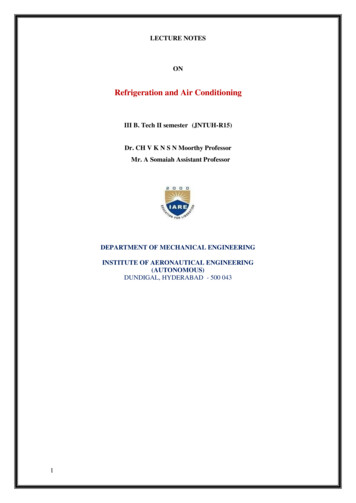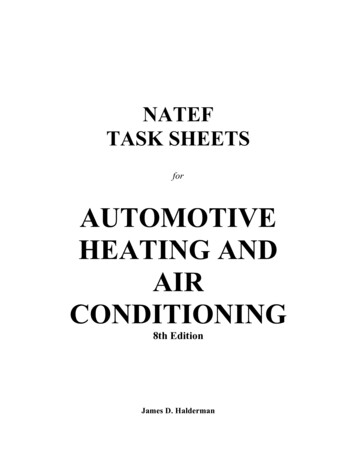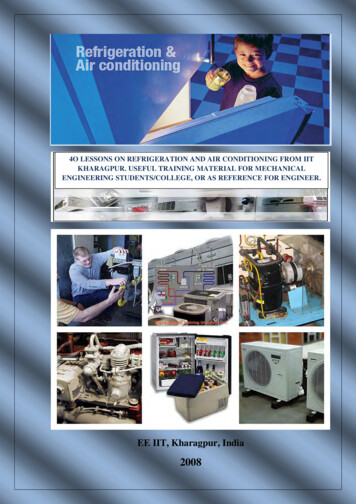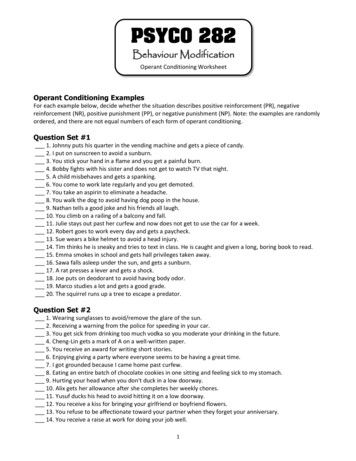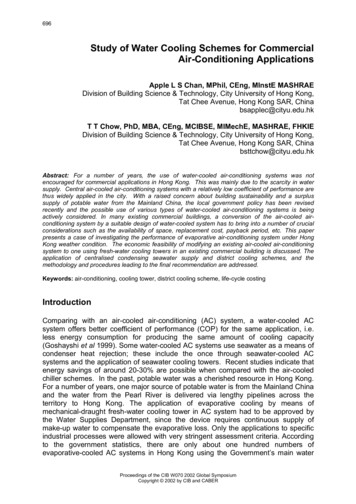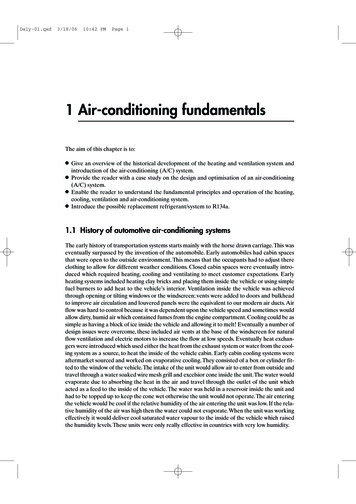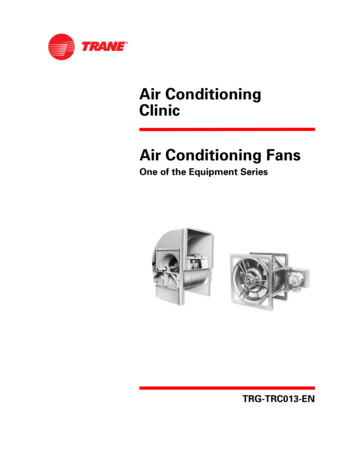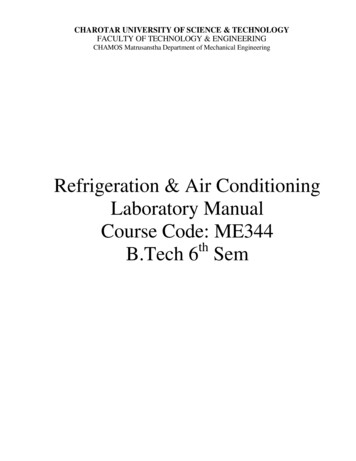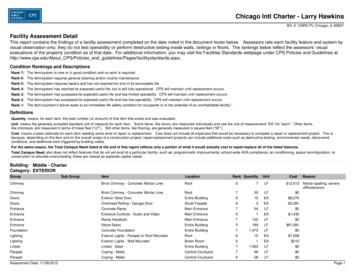
Transcription
UNIT 7 AIR CONDITIONING EQUIPMENTAND THEIR APPLICATIONSAir ConditioningEquipment and s7.2Food Preservation7.2.1 Factors Contributing to Food Spoilage7.2.2 Causes of Food Spoilage7.2.3 Food Storage Conditions and Distribution7.3Cold Storage7.4Freezers7.4.1 Types of Freezer7.4.2 Refrigeration Load in Freezer7.4.3 Calculation of Freezing Time7.5Transport Refrigeration7.5.1 Refrigerated Trucks and Trailers7.5.2 Refrigerated Railway Cars7.5.3 Marine Refrigeration7.5.4 Refrigeration in Air Transport7.6Air Conditioning7.7Miscellaneous7.7.1 Textile Industry7.7.2 Photographic Processing7.7.3 Year Round Air Conditioning7.7.4 Poultry Products7.7.5 Fishery Products7.7.6 Bakeries7.7.7 Freeze Drying7.7.8 Dairy Refrigeration7.7.9 Breweries7.17.8Summary7.9Answers to SAQsINTRODUCTIONThe most significant application of refrigeration is in food preservation, whetherit is by way of processing or for storage. Processing is done by heating, heatdrying, etc., and by refrigeration such as in chilling, freezing or freeze-drying.Storage may be of either chilled or frozen product. Some of the importantproducts, involved in processing are candy, beverages, meat, poultry, fish, bakeryand dairy products fruits and vegetables, etc. An interesting feature of the chilledand frozen food industry is the cold chain that must be maintained from the farmto the consumer. An important link in this chain is the transport refrigeration.97
Refrigeration andAir ConditioningObjectivesAfter studying this unit, you should be able to study the food preservation, study the transport refrigeration, know about freezing equipment, and know about comfort air condition.7.2FOOD PRESERVATION7.2.1 Factors Contributing to Food SpoilageAll types of foods, either plant or animal, contain basically three major molecularcomponents, carbohydrates, proteins and fats. These chemical compoundsprovide vitamins and minerals required by the man.The destruction of one of the above-mentioned ingredient causes the spoilage ofthe food. The spoilage period may vary according to the molecular structure ofdifferent foods. The spoilage of food comes in the form of bad odour, uncommoncolour, bad taste and physical appearance. The result of spoilage on the food maybe loss of weight, softening, souring, rotting, wilting or molding or may be incombined form. Fruits and vegetables after harvesting soften and rotting starts in lapseof time if not protected properly. Milk gives sour taste after its deterioration which is the sign of itsspoilage. Fatty foods like butter and cheese become dark when spoiled and givesour-odour. Eggs lose their weight and give very strong had smell on spoilage. Slimy coating is formed on the surface of the meat which is anindication of its spoilage.The spoilage of the different foods appears in different manner as described abovebut ultimately it is the decomposition of the molecular components in differentforms which makes the food non-eatable.7.2.2 Causes of Food SpoilageThe preservation of food is defined as the preservation of palatability andnutritive value of food preventing the natural spoilage with respect to time.The spoilage of the food may start within the food or may be by an externalagency but in most of the cases, it is the effect of both combined simultaneously.Before going to study the preservation of food, it is necessary to study thespoilage agents in detail which are responsible for the destruction of food.The spoilage agents are mainly divided into two major groups(a)Enzymes(b)Micro-organisms Bacteria, Yeast, Molds.98
7.2.3 Food Storage Conditions and DistributionMany meats, fish, fruits, and vegetables are perishable, and their storage life canbe extended by refrigeration. Fruits, many vegetables and processed meat, such assausages, are stored at temperatures just slightly above freezing to prolong theirlife. Other meats, fish, vegetables, and fruits are frozen and stored many monthsat low temperatures until they are defrosted and cooked by the consumer.Air ConditioningEquipment and theirApplicationsThe frozen-food chain typically consists of the following links: freezing, storagein refrigerated warehouses, display in a refrigerated case at food markets, andfinally storage in the home freezer or frozen-food compartment of a domesticrefrigerator.Food FreezingEarly attempts to freeze food resulted in a product laced with ice crystalsuntil it was discovered that the temperature must be plunged rapidly throughthe freezing zone. Approaches to freezing food includes air-blast freezing,where air at approximately – 30 C is blown with high velocity overpackages of food stacked on fork-lift pallets; contact freezing, where thefood is placed between metal plates and surfaces; immersion freezing,where the food is placed in a low-temperature brine; fluidized-bed freezing,where the individual particles are carried along a conveyor belt and kept insuspension by an upward-directed stream of cold air and freezing with acryogenic substance such as nitrogen or carbon dioxide.Storage Conditions and DistributionFruits and vegetables should be frozen quickly after harvesting and meatsfrozen quickly after slaughter to maintain high quality. Truckload andrailcar-load lots are then moved to refrigerated warehouses where they arestored at – 20 to – 23 C, perhaps for many months. To maintain a highquality in fish, the storage temperature is even lower.Food moves from the refrigerated warehouses to food markets as needed toreplenish the stock there. In the market the food is kept refrigerated indisplay cases held at 3 to 5 C for dairy products, unfrozen fruits andvegetables. Frozen foods and ice cream are kept at approximately - 200. Inthe United States about 100,000 refrigerated display cases are sold eachyear.The consumer finally stores the food in a domestic refrigerator or freezeruntil used. Five million domestic refrigerators are sold each year in theUnited States, and for several decades styling and first cost were paramountconsiderations in the design and manufacture of domestic refrigerators. Theneed for energy conservation, however, has brought back the engineeringchallenge in designing these appliances.7.3COLD STORAGEThough cold storage is understood to be merely an application of refrigeration, itis in fact a complete air-conditioning system in which room air is cooled to toomuch lower temperature over a cooling coil and supplied back to the storagespace. The conditions maintained inside the storage space depend on the nature ofthe product stored. It is to be noted that in cold storages, often, strict control ofboth temperature and relative humidity is required. Also, the storage life dependsa great deal on the temperature at which a product is stored. The required storage99
Refrigeration andAir Conditioningconditions for a number of important food products are given in Table 7.1 It isseen that in the case of bananas, there is no storage period. Instead, there is aperiod of ripening. Bananas cannot he stored after they have ripened. The besttemperature for slow ripening is 14.5 C. Further, in the case of milk, the storagetemperature is 0.5 C, whereas its highest freezing temperature is – 0.6 C. Thus,air is to be maintained within a close tolerance of 0 C so that milk does notfreeze. The same is also true for the pasteurization process.Table 7.1: Storage Conditions and Properties of Food productsProductTemperatureRelativeApproximate CHumidityStorage Life%%Apples– 1 to 085-90Bananas14.595Butter0 to 4.4Milk,PasteurizedEggsFish, freshWatercontentHighestFreezingpoint C84.1– 1.5For ripening in8-10 days74.8–0.880-852 months15.5-16.50.5-7 days87– 0.6– 1.5 to– 0.580-856-9 months66– 2.290-965-15 days62-85– 2.20.5 to 1.5–frozen– 23.5 to– 1890-958-10 days62-85-Grapes– 0.585-903-8 weeks81.9– 1.30 to 188-921-6 weeks62-77– 2.2– 23.5 to– 1890-959-12 months62-77–Beef, freshFrozenMangoes1085-902-3 weeks81.4– 0.9Potatoes, latecrop3 to 4.585-905-8 months77.8– 0.6Tomatoes,green14 to 2185-902-4 weeks94.7– 0.6Ripe7 to 1085-902-7 days94.1– 0.57.4FREEZERSSince properly frozen foods have a much longer storage life than cold-storedfoods and also retain better quality, the emphasis is on the development of frozenfood storages and techniques of quick freezing. Among the common products thatare preserved by freezing are fish, meat, vegetables, such as beans, sprouts,carrots, cauliflower, peas and spinach, various tissues and organs, etc. Frozenshrimp is one of the most valuable foreign-currency earners for India.7.4.1 Types of FreezerThere are three basic types of freezers:100(a)Air-blast freezers in which cold air is blown over the product.(b)Contact or plate freezers in which the product is brought in directcontact with a refrigerated surface.
(c)Immersion or spray freezers in which the product is immersed in orsprayed with a liquid refrigerant.Air ConditioningEquipment and theirApplicationsAir blast and contact-plate freezers are the two most common types used inindustry. Contact-plate freezers do not have the versatility of the air-blastfreezers. The former can only be used to freeze regularly shaped blocks. Thelatter can he used for a variety of irregular shaped as well as small sized productssuch as peas, french fries, shrimp, etc., which results in individual quick-freezing(IQF) of each piece. Air blast freezers can be freezing tunnel type, belt freezers orfluidized bed type freezers. Immersion freezers use liquid freezants atatmospheric pressure, the corresponding temperatures being – 196 C with N2 and– 30 C with R 12.To achieve quick freezing in air blast freezers, the air flow rates should be highFigure 7.1 shows the influence of air velocity on freezing time. A high airvelocity will mean shorter freezing time but more fan power. An optimum airspeed of 5 m/s is recommended for most purposes. In continuous air-blastfreezers, even higher speeds, of the order of 10 to 15 m/s, could also beeconomically employed as that would result in smaller freezer length and lowercost due to reduced freezing time.Figure 7.1: Influence of Air Velocity on Freezing TimeFigure 7.2 shows the schematic diagram of an air-blast freezer in which a movingbelt carries the product. The belt can also be replaced by trolleys and the productstacked in multilayered trays.Figure 7.2: Continuous Belt Air-Blast Freezer with Cross-Flow of AirIn well-designed freezers, the fan power is of the order of 25 to 30 per cent of therefrigeration load. If the air-flow rate is very large, the fan power may be greater.As a result of small dehumidified rise and high air flow the temperature rise of airover the product will he very small. An average rise in air temperature of about1.5-2 C is permissible.101
Refrigeration andAir ConditioningAir-blast freezers with batch operation use trolleys or shelves for loading theproduct. Those with continuous operation make use of conveyors or belts. Thelatter are used only if the product can be frozen quickly, the freezing time mustnot exceeds in 30 minutes, otherwise the length of the freezer will become verylarge.7.4.2 Refrigeration Load in FreezersExample 1 illustrates the procedure for calculating the refrigeration load infreezers. In addition to the product load, other loads that need to be considered arethe fan heat, heat leakage through insulation, heat load due to internal lighting,containers and conveyers, heat load due to internal lighting, containers andconveyers, heat load due to defrosting, infiltration load, etc.Example 7.132,400 kg/day of cold fish is to be frozen to –30 C in 10 cm thick blockseach weighing 45 kg. The secondary refrigerant temperature is – 40 C. Theevaporating refrigerant temperature is – 47 C. The fish enters at 30 C. Thefreezing cycle time may be taken as 4 hours. Given:Specific heat of thawed fish 3.77 kJ/kg CLatent heat of fusion of fish 251.2 kJ/kgSpecific heat of frozen fish 1.67 kJ/kg CCalculate the number of blocks frozen per cycle and refrigeration duty ofthe plant for 18 hours running time.SolutionNumber of blocks/day 32400 720 blocks/day45Number of freezing cycles/day 24 64Number of blocks frozen per cycle 720 120 blocks/cycle6Fish loadingm 32400 0.375kg/s 24 3600 Sensible cooling to a freezing temperature of 0 CQ 1 0.375 3.77 30 42.4kWLatent heat of fusionQ 2 0.375 251.2 94.2kWSensible cooling to 0-30 C102
Q 3 0.375 1.67 30 18.8 kWAir ConditioningEquipment and theirApplicationsTotal product loadQ p 42.4 94.2 18.8 155.4 kWProduct load for 18 hours running timeQ 155.4 24 207.2 kW187.4.3 Freezing TimeThe time taken to lower the temperature of the product from its initial temperatureto a given temperature at its thermal centre is called the freezing time. The finaltemperature is generally the intended storage temperature of the product. Forexample, in the case of fish, the recommended storage temperature is – 30 C. Toensure quick freezing, the freezer temperature must be below this temperature. Itis desired that after freezing, the temperature of the thermal centre should bereduced to at least – 20 C so that the average temperature of the fish is near thestorage temperature of – 30 C. The freezing time will, therefore, be the timerequired to reduce the thermal centre from its initial temperature to – 20 C. Theresidence time of the product in the freezer is, therefore, equal to its freezing time.A precise calculation of the freezing time for irregular-shaped product is difficult.But for uniformly-shaped products such as rectangular blocks, suitable relationshave been proposed. However, they often do not take into account the precoolingfrom the initial temperature to the final temperature. They assume that the producthas been chilled initially, and that all extraction of heat is at the freezingtemperature. The presence of other factors such as packing, etc., may also giveerroneous results. Nevertheless, calculations by the finite-difference method,using a computer, give very good results.A solution for the calculation of temperature distribution throughout a mass, inwhich a change of state is occurring, has been proposed by Neuman for freezedrying. The same can be applied for freezing. The equations expressing thetemperature as a function of the time and position in an infinite slab with a changeof state are available but are not given in this text because they involvedmathematics for which reader may not be prepared. In calculating freezing time itis assumed that surface comes to temperature of freezing media immediately.7.5TRANSPORT REFRIGERATIONThe ‘cold chain‟ principle of food handling and distribution is that the productwill be maintained at suitable conditions all the way to the point of sale. Thisrequires transport and various kinds of storage.The transport of cooled produce, using mechanical refrigeration, was one of thefirst major uses, dating back to 1880 and only 20 years after the first static coldstorage.7.5.1 Refrigerated Trucks and TrailersThese vehicles are refrigerated to maintain temperatures of either 1.5 to 4 C forcold foods or – 18 C for frozen foods. The types of refrigeration systems used aregiven below.103
Refrigeration andAir ConditioningProduct SubcoolingWith the use of improved insulating materials, it is possible to drasticallycut the transmission load of vehicles. In that case, use may be made of thestorage capacity of the product itself for cold by subcooling it to as low atemperature as possible before transporting for short distances. Thus evenafter reaching the destination, the temperature of the product is below thetemperature of the storage requirement. Examples are tankers for milk,orange juice, etc.Using Water IceThe top of the product can be suitably iced. Again, it is a satisfactorymethod for short distances and for some products only. The refrigeratingeffect produced by the melting of ice is 335.4 kJ/kg.Water Ice in Bunker with Forced Air CirculationFigure 7.3 shows the sketch of an ice bunker that is fitted in front of aninsulated vehicle. Air is sucked over ice by the blower taking its drive fromthe engine. A half HP blower will add a heat equivalent of 0.37 kW. Amixture of ice and salt can also be used for lower temperatures up to – 9 C.Figure 7.3: Ice Bunker in Transport RefrigerationUsing Dry IceDry ice is used in many small retail trucks for the delivery of frozen food,such as ice-cream. The usual positioning of the dry-ice blocks is in theceiling. The cooling is by natural convection. When forced convection isemployed, dry ice may be placed in bunkers just like water ice. Therefrigerating effect produced by the sublimation of dry ice, which takesplace at a temperature of – 78.5 C, is 605.5 kJ/kg. In the use of dry ice, caremust be taken to avoid bums due to low temperature, and suffocation due tolack of oxygen.104
Using Liquid Nitrogen or Liquid Carbon Dioxide SprayDue to the expansion of the industry for the manufacture of oxygen, byliquefaction of atmospheric air, liquid nitrogen has become available almostas a by-product. It has, therefore, come in use for the transport of frozenfood. It may, however, be noted that liquid nitrogen has a normal boilingpoint of –195.6 C. This is an extremely low temperature from the point ofview of COP and refrigeration economy. Liquid nitrogen is, therefore, notrecommended if it is not available as a by-product.Air ConditioningEquipment and theirApplicationsEutectic Plates with Station ChargingEutectic plates forming channels are placed all round the body of thevehicle. They contain an eutectic solution which can be frozen by arefrigerant flowing in a coil immersed in the solution. The coil is connectedto a mechanical refrigeration system at the charging station. Cooling isproduced by the evaporation of the primary refrigerant in the coil. When thesolution is frozen, the truck loaded with the product for delivery is ready fordeparture.Eutectic Plates with Vehicle-Mounted Condensing UnitThis system is becoming increasingly popular because of economy as wellas reliability for the transport of frozen foods. Eutectic plates are used formaintaining the product at the required temperature. However, when thefrozen eutectic has melted, the vehicle-mounted condensing unit can bestarted. Further, the condensing unit has an auxiliary drive mounted on thevehicle when it is in use and an electric motor drive for use at the chargingstation.Mechanical Refrigeration with Independent Engine or Electric MotorThe mechanical-refrigeration system mounted on the vehicle has anindependent engine. Some are also equipped with an electric motor forstand-by operation at the charging station. These units are available in tworanges:(a) 5.86 to 10.3 kW capacity at 1.5 C.(b) 1.76 to 5.28 kW capacity at – 18 C in a 40 C environment.Mechanical Refrigeration Deriving Power from Vehicle Engine orTransmissionThere are many practical designs available. The refrigeration compressormay be either directly coupled to the engine, or may take off the powerthrough transmission. In one design, the engine runs an alternator. The A.C.current is rectified and is used to run D.C. motors for compressor and fans.The refrigeration is, however, produced only when the vehicle engine is inoperation.7.5.2 Refrigerated Railway CarsMost refrigerated railway cars use ice bunkers with water ice or ice-and-saltmixture. The recharging of ice is required at intermediate stations on theroute. Nowadays, the mechanical-refrigeration system is being increasinglyadopted. It is provided with an independent diesel-generator set so thatrefrigeration is independent of the car movement. The normal generatorcapacity is 20 kW.105
Refrigeration andAir Conditioning7.5.3 Marine RefrigerationA special feature of marine transport is the varying climate, ranging from extremehot to extreme cold, through which the ship has to pass during the course of itsjourney. The insulation and fittings should be suitable both for warm and coldwater routes. Thus a vapour barrier for moisture should be provided on both sidesof the insulation. Corkboard continues to be favoured as an insulation because ofits many desirable characteristics, such as structural strength, fire-resistantproperty, low permeability for moisture, etc.In the case of cargo, the refrigeration system should be capable of providing anytemperature between – 23.5 and 12.5 C. R 12 with reciprocating compressors ispresently used as a refrigerant. R 22 is not recommended because of its problemof critical oil miscibility. Compound compression is employed. Parallel operationis not recommended with R 12 as there is a tendency for oil to migrate and floodone compressor while starving another. Accordingly, each evaporator has anindependent compressor. This involves the use of a large number of compressors.The system can be made more economical by the use of parallel brine circuits incooler coils and fewer condensing units. Capacity control is obtained by speedvariation or cylinder cut-outs and cylinder unloading. Condensers are of the shelland-tube type using sea water for cooling.Corrosion-resistant cupro-nickel material is, therefore, used for tubes and endcovers. A receiver capable of holding 20 per cent more in addition to the wholecharge is essential. The liquid line should emerge from both ends of thecondenser, and later joining into one. This ensures continuous draining of theliquid during roll or pitch of the ship.In addition to the cargo, ships must have their own stores. These stores have to bemuch bigger for passenger vessels. They also have a ventilated area for some ofthe items, such as onions and potatoes.Fishing vessels use ice for short distances from the shore, but deep-sea fishingtrawlers which remain away for months together must have mechanicalrefrigeration.7.5.4 Refrigeration in Air TransportRefrigerated air transport of some commodities can be justified on the basis ofsaving in the time and preservation of quality. In some passenger aircraft, thecargo compartments are cooled by the air-conditioning system itself. In cargoaircraft, the perishables are pre-cooled before shipment. For transit refrigeration, ifnecessary, refrigerant packages of water ice, dry ice or other substances are used.7.6AIR CONDITIONING7.6.1 Comfort Air ConditioningEffective temperature (ET) is defined as that temperature of saturated air at whichthe subject would experience the same feeling of comfort as experienced in theactual unsaturated environment. Figure 7.4 shows, for example, a line of ET 21.7 C. At lower humidities, the DBTs of air can be higher for the same ET andfor the same feeling of comfort. Thus at a higher DBT, the body would lose moreheat in the form of latent heat, i.e., by the evaporation of perspiration. An increasein temperature can also he compensated by an increase in velocity. For example,an increase of 2 to 3 C in DBT can be compensated by increasing the air velocityfrom 0.1 to 0.3 m/s.106
Based on the concept of effective temperatures some comfort charts have beendeveloped. To mention one, there is the Fanger‟s comfort chart. These may bereferred to when a compromise in the inside design conditions is to be achieved.In addition to the comfort charts, some comfort equations have also beendeveloped.Air ConditioningEquipment and theirApplicationsThe general practice is to recommend the following optimum inside designconditions for comfort for summer air conditioning:ET21.7 CDBT25 1 CRH50 5%The corresponding room air velocity is 0.4 m/s. The points of equal comfort areshown in Figure 7.4.Figure 7.4 : Effective Temperature LinesDuring winter, the body gets acclimatized to withstand lower temperatures.Consequently, a DBT of 21 C at 50 per cent RH and 0.15-0.2 m/s air velocity isquite comfortable.In addition to the maintenance of temperature, humidity and air velocity, it is alsoimportant to maintain the purity of room air. Even if there are no sources ofproduction of pollutants within the conditioned space, the carbon dioxide contentof air increases because of the occupants. It is, therefore, necessary to introducefresh air or ventilation air into the space. The requirement of ventilation air ismuch more when some occupants are smoking. In the case of auditoriums,because of very large occupancy, the ventilation air requirement is very large.Hence there is the need to prohibit smoking in auditoriums and assembly halls.Table 7.2 gives the ventilation air requirements for some applications.Table 7.2: Ventilation Air RequirementsApplicationApartmentsOffices and factoriesRestaurantsBoard roomsDepartment storesTheatresHostel roomsHospital wardsHospital operationtheatres* Cubic meter per minSmokingstatusSomeOccasional-someSomeVery l outdoor0.280.210.560.140.140.7-Cmm/mfloor area0.030.0015-107
Refrigeration andAir Conditioning7.7MISCELLANEOUS7.7.1 Textile IndustryTextiles, like paper, are sensitive to changes in humidity and to a lesser extentchanges in temperature. The yarn in modern textile plants moves at tremendousspeeds, and changes in the flexibility and strength of the textile or generation ofstatic electricity must be prevented.7.7.2 Photographic ProcessingThe photographic-products industry is a large user of air conditioning andrefrigeration. Raw photographic material deteriorates rapidly in high temperaturesand humidities, and other materials used in coating film require careful control oftemperature.7.7.3 Year-Round Air-ConditioningIn many countries, the summers and winters both are very uncomfortable. Undersuch adverse weather conditions, it is necessary to have an air conditioningsystem which will provide comfort conditions throughout the year. Year roundair-conditioning must be capable of maintaining a specified temperature andhumidity within the air-conditioned spaces regardless of outside weatherconditions.7.7.4 Poultry ProductsPoultry meat is preserved both by chilling and freezing. Chilling requires a lowercapital investment whereas freezing offers quality and flexibility of operation.A major fraction of poultry meat is processed and transported by liquid chillingby the use of flake ice. Air chilling results in a considerable amount ofdehydration at the surface. The approximate time required for chilling to 7 C isabout 115 minutes for dressed birds, 50 minutes for eviscerated birds and 25minutes for cut-up ones.As for freezing, the use of air-blast tunnels operating at air temperatures of – 29 to– 40 C and air velocities of 2.5 m/s or more is recommended. This ensures rapidfreezing which is essential to obtain good quality and appearance.Cooling is also required in poultry farms. A temperature higher than 29 C resultsin reduced egg production of lesser weight and thinner shells. A temperature of24 C is recommended for poultry-keeping.7.7.5 Fishery ProductsRefrigeration is required in many ways in the processing, preservation andtransport of fresh and frozen fish and their products. Care starts from the stage ofcatching in fishing boats and trawlers.Icing of fish is first done to chill it to a temperature of 0 C. The melt-water alsohelps to wash off the slime and bacteria. Often the fish are stored in tanks usingrefrigerated sea water at – 1 C. It is found that shrimp when stored withrefrigerated sea water is superior to that stored with ice. The storage life of chilledfish is normally 10 – 15 days.Again, more and more of fish are being frozen these days. The valued varieties offish that are frozen include salmon, shrimp, shell fish, etc. Individual quickfreezing (IQF) techniques are preferred for these products. Quick freezing hasmany advantages. It prevents bacterial spoilage and ensures rapid handling,108
packaging and good appearance of the product, and also makes optimumutilization of the freezer space. Quick-freezing is achieved by using lowrefrigeration temperaturesAir ConditioningEquipment and theirApplications7.7.6 BakeriesBread is the most important bakery product. During the preparation of the mix forthe dough, the heat of hydration and heat of friction of the churner, equivalent tothe electrical input power, are generated. As the temperature of dough should notexceed 24 – 25 C, the best way to keep the temperature low is to add chilledwater at 2 – 4 C for the preparation of the mix. The mixer is jacketed with adirect expansion coil at a temperature of 0 C.The doughs are then placed in troughs for fermentation for a period of 3½ to 5hours. During the process, the temperature may rise by 4 – 6 C. It is, therefore,desirable to keep them in a room at a temperature of 26 C.Refrigeration is needed in the manufacture of other bakery products also in orderto maintain uniformity of the product, prevent spoilage and for storage.7.7.7 Freeze DryingFreeze drying is a successful process of liquid separation from a product in afrozen state, achieved by sublimation under vacuum. The sublimation serves toobtain a product that retains even its volatile components and initial quality, andthe vacuum is used to maintain the physical state as frozen and to direct thevapour flow. At present, the main problems to the application of the process ingeneral are; (a) the relatively high cost of the freeze-dried product by sublimationdehydration due to high vacuum, (b) very low temperature refrigeration to prefreeze the product and then to condense the sublimated vapour, (c) thecomplicated operational control and (d) the long duration of the freeze-dryingtime. Characteristically, however, the cost is not the determining factors for themanufacture of certain products including blood plasma, life-saving drugs such asgamma-globulin, and high value food products such as mushrooms, shrimp,prawns, etc.Figure 7.5 shows a model of the freeze-drying process with radiant heating. Theprofile shows the temperature distribution.The dehydration takes
(IQF) of each piece. Air blast freezers can be freezing tunnel type, belt freezers or fluidized bed type freezers. Immersion freezers use liquid freezants at atmospheric pressure, the corresponding temperatures being - 196 C with N 2 and - 30 C with R 12. To achieve quick freezing in air blast freezers, the air flow rates should be high

